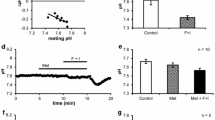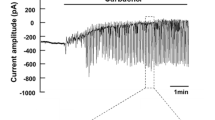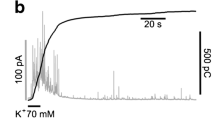Summary
This study examines the activation of divalent cation entry into rat parotid gland acinar cells by using Mn2+ as a Ca2+ surrogate cation. Following muscarinic-cholinergic stimulation of dispersed parotid acini with carbachol (10 μ m), the onset of internal Ca2+ release (cytosolic [Ca2+], [Ca2+] i , increase) and the stimulation of Mn2+ entry (increase in fura2 quenching) are not simultaneously detected. [Ca2+] i elevation, due to intracellular release, is detected almost immediately following carbachol addition and peak [Ca2+] i increase occurs at 6.0 ± 0.8 sec. However, there is an interval (apparent lag) between carbachol addition and the detection of stimulated Mn2+ entry. This apparent lag is decreased from 26 ± 3.1 sec to 9.2 ± 1.5 sec when external Mn2+ ([Mn2+] o ) is increased from 12.5 to 500 μm. It is not decreased further with increase in [Mn2+] o from 500 μ m to 1 mm(9.8 ± 2.1 sec), although both intracellular free Mn2+ and [Mn2+-fura2]/[fura2] increase. Thus, at [Mn2+] o <500 μ m, the observed lag time is partially due to a limitation in the magnitude of Mn2+ entry. Furthermore, neither peak [Ca2+] i nor the time required to reach peak [Ca2+] i is significantly altered by [Mn2+] o (12.5μ m to 1 mm). At every [Mn2+] o tested (i.e., 12.5 μ m−1 mm), the apparent lag is significantly greater than the time required to reach peak [Ca2+] i . However, when carbachol stimulation of the [Ca2+] i increase is attenuated by loading the acini with the Ca2+ chelator, 2-bis(O-aminophenoxy)ethane-N,N,N′,N′-tetraacetate (BAPTA), there is no detectable lag in carbachol stimulation of Mn2+ entry (with 1 mm [Mn2+] o ). Importantly, in BAPTA-loaded acini, carbachol stimulates Mn2+ entry via depletion of the internal Ca2+ pool and not via direct activation of other divalent cation entry mechanisms. Based on these results, we suggest that the apparent lag in the detection of carbachol stimulation of Mn2+ entry into parotid acinar cells is due to a retardation of Mn2+ entry by the initial increase in [Ca2+] i , due to internal release, which most likely occurs proximate to the site of divalent cation entry.
Similar content being viewed by others
References
Aub, D.L., Putney, J.W., Jr. 1984. Metabolism of inositol phosphates in parotid cells: Implications for the pathway of the phosphoinositide effect and for the possible messenger role of inositol triphosphate. Life Sci. 34:1347–1355
Baum, B.J., Ambudkar, I.S., Helman, J., Horn, V.J., Melvin, J.E., Mertz, L.M., Turner, R.J. 1990. Dispersed salivary gland acinar cell preparations for use in studies of neuroreceptor coupled secretory events. Methods Enzymol. 192:26–37
Baum, B.J., Ambudkar, I.S., Horn, V.J. 1991. Neurotransmitter regulation of calcium mobilization in salivary cells. In: The Biology of the Salivary Glands. K. Vergona, editor, (in press)
Berridge, M.J., Irvine, R.F. 1989. Inositol phosphates and cell signalling. Nature 341:197–205
Bird G., St Rossier, M.F., Hughes, A.R., Shears, S.B., Armstrong, D.L., Putney, J.W., Jr. 1991. Activation of Ca2+ entry into acinar cells by a non-phosphorylatable inositol triphosphate. Nature 352:162–165
Dissing, S., Nauntofte, B., Sten-Knudsen, O. 1990. Spatial distribution of intracellular, free Ca2+ in isolated rat parotid acini. Pfluegers Arch. 417:1–12
Foder, B., Scharff, O., Thastrup, O. 1989. Ca2+ transients and Mn2+ entry in human neutrophils induced by thapsigargin. Cell Calcium 10:477–490
Foskett, J.K., Gunter-Smith, P.J., Melvin, J.E., Turner, R.J. 1989. Physiological localization of an agonist-sensitive pool of Ca2+ in parotid acinar cells. Proc. Natl. Acad. Sci. USA 86:167–171
Hallam, T.J., Jacob, R., Merritt, J.E. 1988. Evidence that agonists stimulate bivalent-cation influx into human endothelial cells. Biochem. J. 255:179–184
Horn, V.J., Baum, B.J., Ambudkar, I.S. 1988. β-adrenergic receptor stimulation induces inositol triphosphate production and Ca2+ mobilization in rat parotid acinar cells. J. Biol. Chem. 263:12454–12460
Hoth, M., Penner, R. 1992. Depletion of intracellular Ca2+ stores activates a Ca2+ current in mast cells. Nature 355:353–356
Hughes, A.R., Takemura, H., Putney, J.W., Jr. 1988. Kinetics of inositol 1,4,5-triphosphate and inositol cyclic 1:2,4,5-triphosphate metabolism in intact parotid acinar cells. J. Biol. Chem. 263:10314–10319
Irvine, R.F. 1990. ‘Quantal’ Ca2+ release and the control of Ca2+ entry by inositol phosphates—a possible mechanism. FEBS Lett. 263:5–9
Irvine, R.F., Anggard, E.E., Letcher, A.J., Downes, C.P. 1985. Metabolism of inositol 1,4,5-triphosphate and inositol 1,3,4-triphosphate in rat parotid glands. Biochem. J. 229:505–511
Jacob, R. 1990. Agonist-stimulated divalent cation entry into single cultured umbilical vein endothelial cells. J. Physiol. 421:55–77
Kasai, H., Augustine, G.J. 1990. Cytosolic Ca2+ gradients triggering unidirectional fluid secretion from exocrine pancreas. Nature 348:735–738
Kass, G.E.N., Llopis, J., Chow, S.C., Duddy, S.K., Orrenius, S. 1990. Receptor-operated calcium influx in rat hepatocytes. J. Biol. Chem. 265:17486–17492
Kwan, C.-Y., Putney, J.W., Jr. 1990. Uptake and intracellular sequestration of divalent cations in resting and methacholine-stimulated mouse lacrimal acinar cells. J. Biol. Chem. 265:678–684
Loessberg, P.A., Zhao, H., Muallem, S. 1991. Synchronized oscillation of Ca2+ release in agonist-stimulated AR42J cells. J. Biol. Chem. 266:1363–1366
Luckhoff, A., Clapham, D.E. 1992. Inositol 1,3,4,5,-tetrakisphosphate activates an endothelial Ca2+ permeable channel. Nature 355:356–358
Marier, S.H., Putney, J.W., Jr., Van De Walle, C.M. 1978. Control of calcium channels by membrane receptors in the rat parotid gland. J. Physiol. 279:141–151
Merritt, J.E., Rink, T.J. 1987. Regulation of cytosolic free Ca2+ in Fura-2 loaded rat parotid acinar cells. J. Biol. Chem. 262:17362–17369
Merritt, J.E., Rink, T.J. 1987. The effects of substance P and carbachol on inositol tris- and tetrakisphosphate formation and cytosolic free calcium in rat parotid acinar cells. J. Biol. Chem. 262:14912–14916
Mertz, L.M., Baum, B.J., Ambudkar, I.S. 1990. Refill status of the agonist-sensitive Ca2+ pool regulates Mn2+ influx into parotid acini. J. Biol. Chem. 265:15010–15014
Mertz, L.M., Baum, B.J., Ambudkar, I.S. 1992. Membrane potential modulates divalent cation entry in rat parotid acini. J. Membrane Biol. 126:183–193
Mertz, L.M., Horn, V.J., Baum, B.J., Ambudkar, I.S. 1990. Calcium entry in rat parotid acini: Activation by carbachol and aluminum fluoride. Am. J. Physiol. 258:C654–661
Parker, I., Ivorra, I. 1990. Inhibition by Ca2+ of the inositol trisphosphate-mediated Ca2+ liberation: A possible mechanism for oscillatory release of Ca2+. Proc. Natl. Acad. Sci. USA 87:260–264
Pietri, F., Hilly, M., Mauger, J.-P. 1990. Calcium mediates the interconversion between two states of the liver inositol 1,4,5,triphosphate receptor. J. Biol. Chem. 265:17478–17485
Petersen, O.H. 1989. Does inositol tetrakisphosphate play a role in the receptor-mediated control of calcium mobilization? Cell Calcium 10:375–383
Petersen, O.H., Gallacher, D.V. 1988. Electrophysiology of pancreatic and salivary acinar cells. Annu. Rev. Physiol. 50:65–80
Putney, J.W., Jr. 1986. A model for receptor-regulated calcium entry. Cell Calcium 7:1–12
Sage, S.O., Merritt, J.E., Hallam, T.J., Rink, T.J. 1989. Receptor-mediated calcium entry in fura-2-loaded human platelets stimulated with ADP and thrombin. Biochem. J. 258:923–926
Takemura, H., Hughes, A.R., Thastrup, O., Putney, J.W., Jr. 1989. Activation of calcium entry by the tumor promotor thapsigargin in rat parotid acinar cells. J. Biol. Chem. 264:12266–12271
Takemura, H., Putney, J.W., Jr. 1989. Capacitative calcium entry in parotid acinar cells. Biochem. J. 258:409–412
Taylor, C.W. 1990. Receptor-regulated Ca2+ entry: Secret pathway or secret messenger? Trends Pharmacol. Sci. 11:269–271
Author information
Authors and Affiliations
Additional information
We appreciate Dr. R.J. Turner's comments during the preparation of this manuscript. We also thank Drs. R.J. Turner, Ofer Eidelman, V.J. Horn, and T. Lockwich for helpful discussions during the course of this work.
Rights and permissions
About this article
Cite this article
Hiramatsu, Y., Baum, B.J. & Ambudkar, I.S. Elevation of cytosolic [Ca2+] due to intracellular Ca2+ release retards carbachol stimulation of divalent cation entry in rat parotid gland acinar cells. J. Membarin Biol. 129, 277–286 (1992). https://doi.org/10.1007/BF00232909
Received:
Revised:
Issue Date:
DOI: https://doi.org/10.1007/BF00232909




